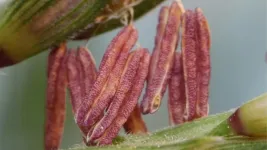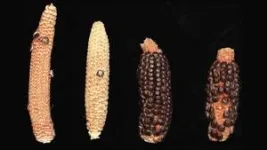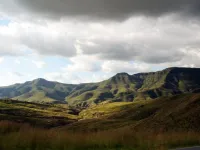(Press-News.org) Cold Spring Harbor Laboratory (CSHL) has begun to unravel a mystery millennia in the making. Our story begins 9,000 years ago. It was then that maize was first domesticated in the Mexican lowlands. Some 5,000 years later, the crop crossed with a species from the Mexican highlands called teosinte mexicana. This resulted in cold adaptability. From here, corn spread across the continent, giving rise to the vegetable that is now such a big part of our diets. But how did it adapt so quickly? What biological mechanisms allowed the highland crop’s traits to take hold? Today, a potential answer emerges.
CSHL Professor and HHMI Investigator Rob Martienssen had been studying RNA interference, the process of small RNAs silencing genes, for more than 20 years when University of Wisconsin researcher Jerry Kermicle reached out with a curious observation. His experiments crossing semi-sterile teosinte hybrids with traditional maize had caused their offspring to behave very unusually. With normal inheritance, the offspring should have eventually become completely sterile or fertile. But no matter how many times Kermicle crossed the hybrids with maize, all the offspring were semi-sterile, too. What was happening?
To figure it out, Martienssen and graduate student Ben Berube sequenced the genomes from hundreds of pollen grains of the semi-sterile offspring. They discovered the same sections from the teosinte genome were present in each.
“There were two pieces of the genome, one on chromosome 5 and one on chromosome 6, that were always inherited. That told us the genes responsible must be in those regions," says Martienssen.
On chromosome 5, they found that a gene called Dicer-like 2 makes a group of small RNAs that are always in semi-sterile hybrids but not traditional maize. With that finding, the Martienssen lab was able to pinpoint what they call Teosinte Pollen Drive (TPD). This “selfish” genetic system eliminates competing pollen grains that lack the gene drive. It causes maize-teosinte hybrids to pass certain traits through males more often than females. The discovery could have significant implications for the agriculture industry. But in Martienssen’s eyes, the finding is even bigger than its potential weed control applications.
“I’m more excited by the evolutionary aspects, what it might mean for the process of domestication, and how it could have been much quicker than we thought," says Martienssen.
If teosinte mexicana is “the Neanderthal of maize,” Martienssen may have found in TPD corn’s “missing link.” The breakthrough could explain how corn came to thrive across America—but also why certain small RNAs are so common in plant and animal sperm cells, including ours.
END
Corn’s ‘missing link’
2024-08-07
ELSE PRESS RELEASES FROM THIS DATE:
Scientists uncover hidden forces causing continents to rise
2024-08-07
Scientists at the University of Southampton have answered one of the most puzzling questions in plate tectonics: how and why ‘stable’ parts of continents gradually rise to form some of the planet’s greatest topographic features.
They have found that when tectonic plates break apart, powerful waves are triggered deep within the Earth that can cause continental surfaces to rise by over a kilometre.
Their findings help resolve a long-standing mystery about the dynamic forces that shape and connect some of the Earth’s most ...
Variability in constituents of e-cigarette products containing nicotine analogues
2024-08-07
About The Study: Discrepancies were observed between labeled and measured concentrations of nicotine analogues in e-cigarettes and e-cigarette liquids marketed as nicotine replacements and exempt from FDA’s regulatory purview. Such discrepancies may lead to uncertainty about user exposure. When coupled with the largely unknown acute and chronic inhalation hazards and addictive potential of nicotine analogues, assessing product risk based on exposure becomes challenging from a clinical and regulatory standpoint. With e-cigarettes increasingly considered for smoking cessation, the advent of nicotine analogue–containing products with ...
A vaping cessation text message program for adolescent e-cigarette users
2024-08-07
About The Study: A tailored, interactive text message intervention increased self-reported vaping cessation rates among adolescents recruited via social media channels.
Quote from corresponding author Amanda L. Graham, PhD:
“Health care providers, teachers, and parents have been asking how to help teens quit vaping. This study is a critical breakthrough that demonstrates the power of a behavioral intervention for vaping cessation. Text messages serve as powerful reminders of an initial commitment to quit and can deliver proven behavior change support right to a young person’s phone.
“We also did not see evidence that teens who quit ...
Neighborhood socioeconomic disadvantage across the life course and premature mortality
2024-08-07
About The Study: Low neighborhood socioeconomic status was associated with premature mortality in this study. The risk of premature mortality was greatest among individuals experiencing persistently low neighborhood socioeconomic status from young to middle adulthood. Place-based interventions that target neighborhood social determinants of health should be designed from a life course perspective that accounts for early-life socioeconomic inequality.
Corresponding Author: To contact the corresponding author, Wayne R. Lawrence, DrPH, email wayne.lawrence@nih.gov.
To access the embargoed ...
Cocaine discovery could pave way for treatment for substance abuse
2024-08-07
You have probably heard of dopamine. The substance also known as the “feel-good hormone”.
Drugs such as cocaine cause a surge of dopamine in the brain. Normally, a protein in the brain called the dopamine transporter (DAT) helps regulate dopamine levels and prevent the brain from thinking that every experience is pleasurable.
However, when affected by cocaine, the brain is unable to regulate dopamine levels. Previously, researchers did not know how cocaine affects the different transporters in the brain, but a new study from the University of Copenhagen has changed that.
“We have learned how cocaine binds to the dopamine transporter, which is ...
Link discovered between sensory neurons and breast cancer metastasis
2024-08-07
Cancer doesn’t grow in a vacuum—each tumor grows in a particular microenvironment within the body and spreads through a tangled web of vasculature and nerves. Scientists have come to understand that the most potent therapies address cancer in context—accounting for both the tumor and the support structure that forms around it.
Now, a new paper in Nature reveals that the activation of sensory nerves within breast tumors is playing a critical role in promoting not only cancer growth but also its spread, known as metastasis. The findings—that sensory neurons ...
Plants show surprising diversity in arid landscape
2024-08-07
Understanding how plants cope with climatic extremes and grazing pressure is important for reliable prediction about future biodiversity and the functioning of dryland ecosystems[1].
An international team, coordinated by KAUST’s Fernando Maestre, has assessed how 20 chemical and morphological plant functional traits jointly respond to changes in aridity and grazing pressure across global drylands. Increasing aridity and grazing pressure could be expected to reduce the level of plant diversity. However, the diversity of plant traits — including key traits linked to nutrient cycling such as specific leaf area and foliar ...
Plasma bubbles and the “engine” of fast radio bursts
2024-08-07
Rome, 7 August 2024 -- Fast Radio Bursts (FRBs) are one of the most recent open mysteries of modern astrophysics. Within a few milliseconds, these powerful events release an immense amount of energy, among the highest observable in cosmic phenomena. FRBs were discovered just over ten years ago and mostly arise from extragalactic sources. Their origin, however, is still uncertain and there are huge ongoing efforts by the astrophysics community around the world to understand the physical processes behind them.
In very few cases, the rapid flash that characterises FRBs coincides with a persistent ...
Microbes and their interactions the focus of major international meeting
2024-08-07
One of the academic world’s largest international meetings addressing topics in microbial ecology, the 19th International Symposium on Microbial Ecology (ISME), will take place in Cape Town, South Africa in August.
More than 1 500 scientists from over 50 countries worldwide will convene at the Cape Town International Convention Centre (CT-ICC) from 18 to 23 August 2024. This will be the first time that this prestigious meeting is held on the African continent.
Prof. Thulani Makhalanyane, chair of the ISME organising committee and professor of microbiology at Stellenbosch University (SU), ...
Heart and brain axis targets in CNS neurological disorders
2024-08-07
Recent advancements highlight the intricate interplay between the heart and brain, underscoring their profound influence on each other, especially concerning central nervous system (CNS) neurological disorders. In light of this, a new special issue aims to explore therapeutic targets that impact both cardiac and cerebral functions. By focusing on these targets, the issue seeks to provide an in-depth understanding of the complex relationship between these vital organs.
For more information and to contribute ...






